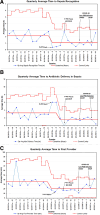Causal Association of Physician-in-Triage with Improved Pediatric Sepsis Care: A Single-Center, Emergency Department Experience
- PMID: 37250616
- PMCID: PMC10219727
- DOI: 10.1097/pq9.0000000000000651
Causal Association of Physician-in-Triage with Improved Pediatric Sepsis Care: A Single-Center, Emergency Department Experience
Abstract
Approximately 75,000 children are hospitalized for sepsis yearly in the United States, with 5%-20% mortality estimates. Outcomes are closely related to the timeliness of sepsis recognition and antibiotic administration.
Methods: A multidisciplinary sepsis task force formed in the Spring of 2020 aimed to assess and improve pediatric sepsis care in the pediatric emergency department (ED). The electronic medical record identified pediatric sepsis patients from September 2015 to July 2021. Data for time to sepsis recognition and antibiotic delivery were analyzed using statistical process control charts (X̄-S charts). We identified special cause variation, and Bradford-Hill Criteria guided multidisciplinary discussions to identify the most probable cause.
Results: In the fall of 2018, the average time from ED arrival to blood culture orders decreased by 1.1 hours, and the time from arrival to antibiotic administration decreased by 1.5 hours. After qualitative review, the task force hypothesized that initiation of attending-level pediatric physician-in-triage (P-PIT) as a part of ED triage was temporally associated with the observed improved sepsis care. P-PIT reduced the average time to the first provider exam by 14 minutes and introduced a process for physician evaluation before ED room assignment.
Conclusions: Timely assessment by an attending-level physician improves time to sepsis recognition and antibiotic delivery in children who present to the ED with sepsis. Implementing a P-PIT program with early attending-level physician evaluation is a potential strategy for other institutions.
Copyright © 2023 the Author(s). Published by Wolters Kluwer Health, Inc.
Conflict of interest statement
GSM receives salary support through the US government National Institute of Child Health and Human Development (NICHD) T32 training grant (1T32HD094671). All the other authors have no financial interest to declare in relation to the content of this article.
Figures


References
-
- Sehgal M, Ladd HJ, Totapally B. Trends in epidemiology and microbiology of severe sepsis and septic shock in children. Hosp Pediatr. 2020;10:1021–1030. - PubMed
-
- Weiss SL, Chair CV, Peters MJ, et al. . Surviving sepsis campaign international guidelines for the management of septic shock and sepsis-associated organ dysfunction in children. Pediatr Crit Care Med. 2020;21:55. - PubMed
Grants and funding
LinkOut - more resources
Full Text Sources
